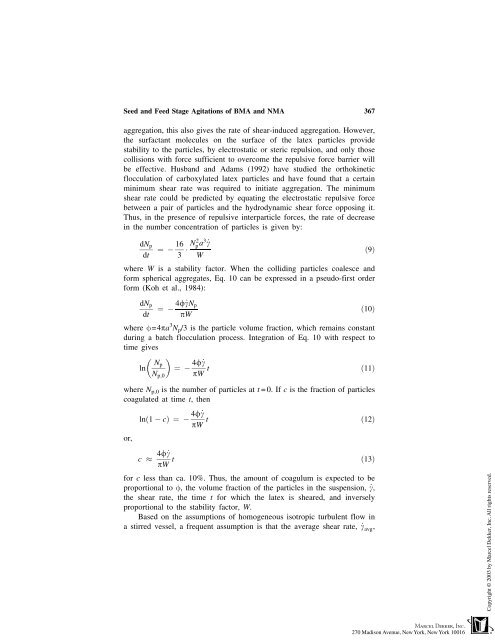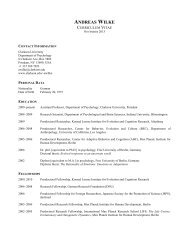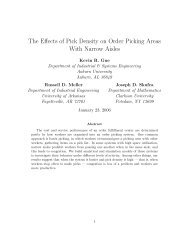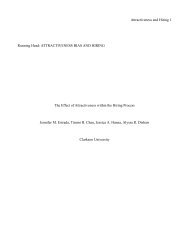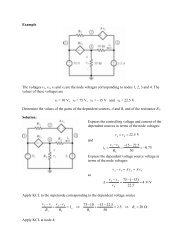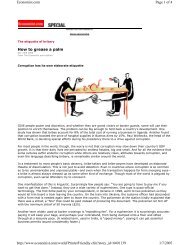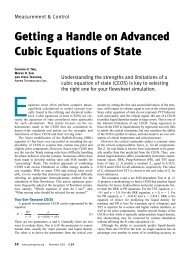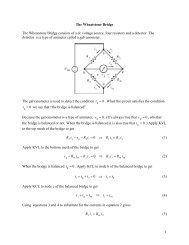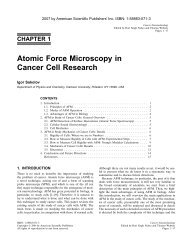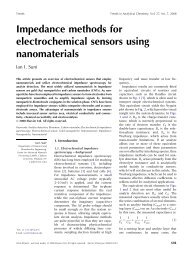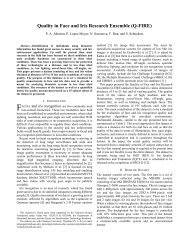Relative Importance of the Effects of Seed and Feed Stage ...
Relative Importance of the Effects of Seed and Feed Stage ...
Relative Importance of the Effects of Seed and Feed Stage ...
Create successful ePaper yourself
Turn your PDF publications into a flip-book with our unique Google optimized e-Paper software.
<strong>Seed</strong> <strong>and</strong> <strong>Feed</strong> <strong>Stage</strong> Agitations <strong>of</strong> BMA <strong>and</strong> NMA 367<br />
aggregation, this also gives <strong>the</strong> rate <strong>of</strong> shear-induced aggregation. However,<br />
<strong>the</strong> surfactant molecules on <strong>the</strong> surface <strong>of</strong> <strong>the</strong> latex particles provide<br />
stability to <strong>the</strong> particles, by electrostatic or steric repulsion, <strong>and</strong> only those<br />
collisions with force sufficient to overcome <strong>the</strong> repulsive force barrier will<br />
be effective. Husb<strong>and</strong> <strong>and</strong> Adams (1992) have studied <strong>the</strong> orthokinetic<br />
flocculation <strong>of</strong> carboxylated latex particles <strong>and</strong> have found that a certain<br />
minimum shear rate was required to initiate aggregation. The minimum<br />
shear rate could be predicted by equating <strong>the</strong> electrostatic repulsive force<br />
between a pair <strong>of</strong> particles <strong>and</strong> <strong>the</strong> hydrodynamic shear force opposing it.<br />
Thus, in <strong>the</strong> presence <strong>of</strong> repulsive interparticle forces, <strong>the</strong> rate <strong>of</strong> decrease<br />
in <strong>the</strong> number concentration <strong>of</strong> particles is given by:<br />
dN p<br />
dt<br />
¼<br />
16 3 N2 p a3 g<br />
W<br />
where W is a stability factor. When <strong>the</strong> colliding particles coalesce <strong>and</strong><br />
form spherical aggregates, Eq. 10 can be expressed in a pseudo-first order<br />
form (Koh et al., 1984):<br />
dN p<br />
dt<br />
¼<br />
4f gN p<br />
pW<br />
ð9Þ<br />
ð10Þ<br />
where f=4pa 3 N p /3 is <strong>the</strong> particle volume fraction, which remains constant<br />
during a batch flocculation process. Integration <strong>of</strong> Eq. 10 with respect to<br />
time gives<br />
<br />
ln<br />
N p<br />
N p;0<br />
<br />
¼<br />
4f g<br />
pW t<br />
ð11Þ<br />
where N p,0 is <strong>the</strong> number <strong>of</strong> particles at t =0. If c is <strong>the</strong> fraction <strong>of</strong> particles<br />
coagulated at time t, <strong>the</strong>n<br />
or,<br />
lnð1 cÞ ¼ 4f g<br />
pW t<br />
ð12Þ<br />
c 4f g<br />
pW t<br />
ð13Þ<br />
for c less than ca. 10%. Thus, <strong>the</strong> amount <strong>of</strong> coagulum is expected to be<br />
proportional to f, <strong>the</strong> volume fraction <strong>of</strong> <strong>the</strong> particles in <strong>the</strong> suspension, g,<br />
<br />
<strong>the</strong> shear rate, <strong>the</strong> time t for which <strong>the</strong> latex is sheared, <strong>and</strong> inversely<br />
proportional to <strong>the</strong> stability factor, W.<br />
Based on <strong>the</strong> assumptions <strong>of</strong> homogeneous isotropic turbulent flow in<br />
a stirred vessel, a frequent assumption is that <strong>the</strong> average shear rate, g<br />
<br />
avg ,


